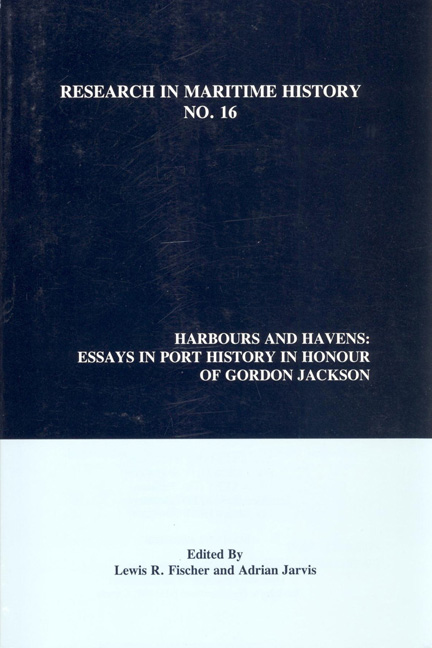Book contents
- Frontmatter
- Contents
- About the Editors
- Contributors
- Introduction
- “Gordon Jackson: An Appreciation”
- “Port History: Some Thoughts on Where it Came from and Where it Might be Going”
- “Port Politics: Interest, Faction and Port Management in Mid-Victorian Liverpool”
- “Our Little Company:' The Wilsons and North Eastern Railway Shipping Company Limited, 1906-1935”
- “The Changing Functions of a Rural Port: Dumfries, 1700-1850”
- “Australian Ports Since 1945”
- “Aspinall, Cornes and Company and the Early Development of the Port of Yokohama”
- “Dubai: From Creek to Global Port City”
- “New York's German Suburb: The Creation of the Port of Bremerhaven, 1827-1918”
- “Capital and Labour in the Port Town of Esbjerg, 1945- 1999”
- “Port Policies: Seaport Planning around the North Atlantic, 1850-1939”
- “Gordon Jackson: A Bibliography”
“The Changing Functions of a Rural Port: Dumfries, 1700-1850”
- Frontmatter
- Contents
- About the Editors
- Contributors
- Introduction
- “Gordon Jackson: An Appreciation”
- “Port History: Some Thoughts on Where it Came from and Where it Might be Going”
- “Port Politics: Interest, Faction and Port Management in Mid-Victorian Liverpool”
- “Our Little Company:' The Wilsons and North Eastern Railway Shipping Company Limited, 1906-1935”
- “The Changing Functions of a Rural Port: Dumfries, 1700-1850”
- “Australian Ports Since 1945”
- “Aspinall, Cornes and Company and the Early Development of the Port of Yokohama”
- “Dubai: From Creek to Global Port City”
- “New York's German Suburb: The Creation of the Port of Bremerhaven, 1827-1918”
- “Capital and Labour in the Port Town of Esbjerg, 1945- 1999”
- “Port Policies: Seaport Planning around the North Atlantic, 1850-1939”
- “Gordon Jackson: A Bibliography”
Summary
The difficulty of inland communication has long encouraged the proliferation of ports along the Scottish coastline with little to choose between them before the expansion and reorientation of trade in the decades following the Restoration. This long period of growth created a new disparity between ports and was linked to the growing specialisation of regional economies. Mineral ports, such as Alloa, Kirkcaldy, Ayr and Irvine, grew rapidly from the mid-eighteenth century, while the bulk of the nation's foreign trade was increasingly channelled through a handful of larger entrepots, notably Port Glasgow and Greenock on the Clyde, and Leith and Bo'ness on the Forth - together accounting for forty-six percent of tonnage entering and fifty-seven percent of tonnage clearing Scottish ports between 1776 and 1780. Such ports benefited from deep-water sites, navigable communication with industrialising hinterlands, extensive commercial networks built from long experience of overseas trade and, in the case of the Clyde, shifts in the direction of trade occasioned by the opening of transatlantic routes. Yet they were atypical: most Scottish ports were considerably smaller and evolved to accommodate the limited requirements of their hinterlands for goods they could not produce, and the ability of local populations to identify and service external markets for the goods they could.
In this respect transport, which in Scotland meant shipping - and in small ports predominately coastal shipping - was crucial. It was the means of interchange within and between regions, diffusing imports from overseas and servicing the requirements of hinterlands for access to external markets and distribution centres. In a national and international context, ports and shipping provided infrastructure for an integrated transport system that facilitated and perpetuated the process of regional specialisation underpinning the industrial revolution and the subsequent exploitation of Britain's favourable factor endowment. Yet with only a handful of notable exceptions Scottish ports, trade and shipping have been neglected by historians. In particular, we know almost nothing of the way small ports experienced or contributed to economic change in this era. Dumfries is typical of the many places that were not major ports serving industrial regions but were nonetheless significant cogs in the development of both local and national economies.
- Type
- Chapter
- Information
- Harbours and HavensEssays In Port History In Honour Of Gordon Jackson, pp. 89 - 110Publisher: Liverpool University PressPrint publication year: 1998



